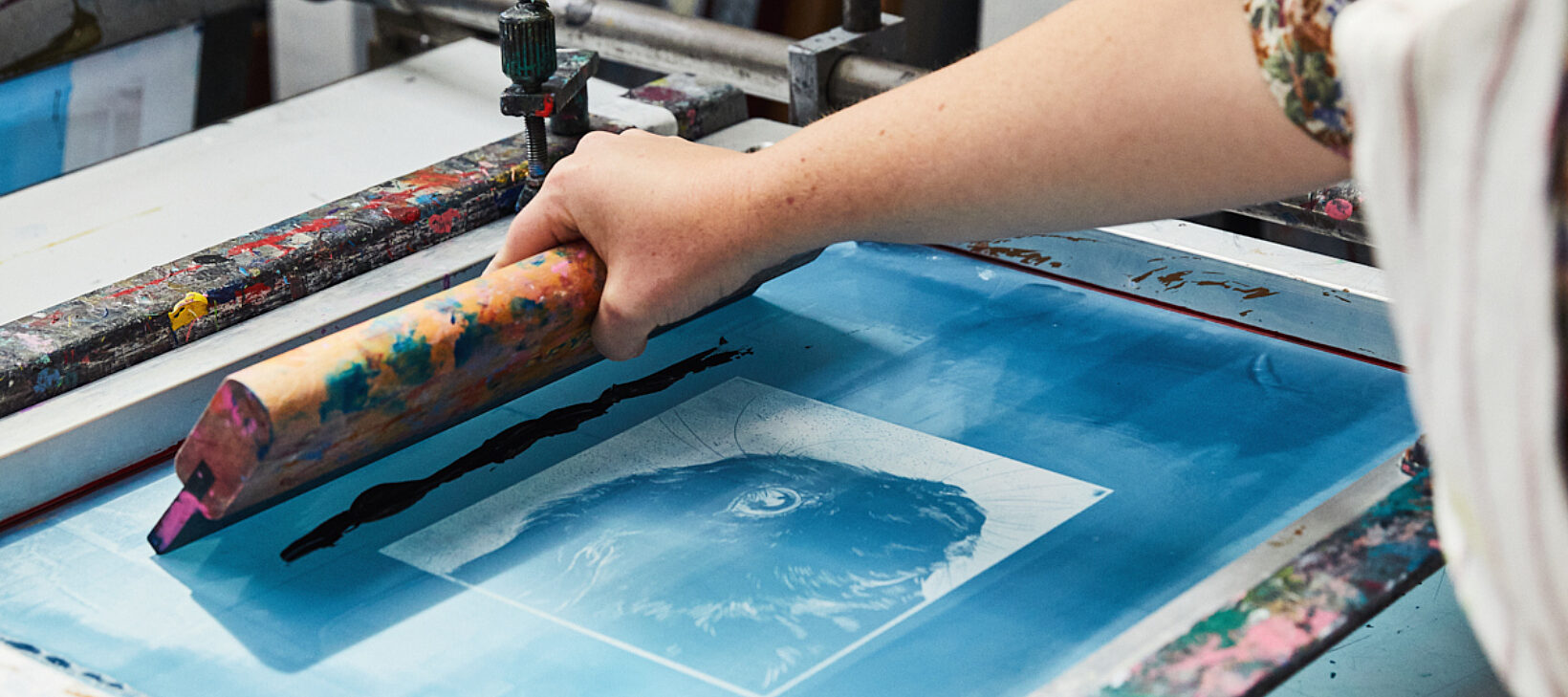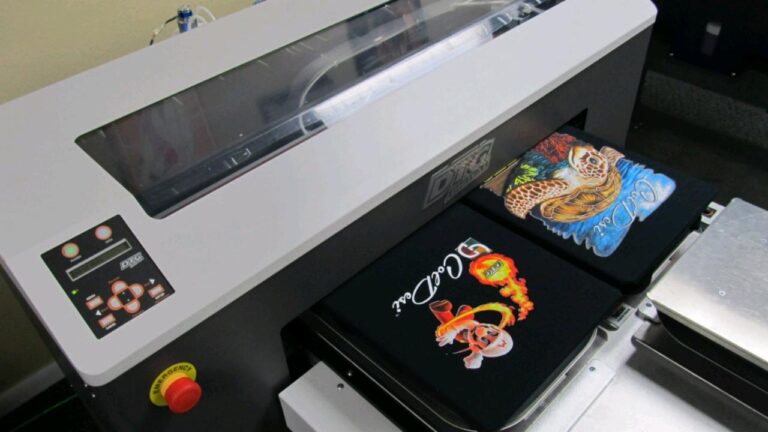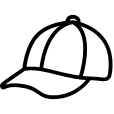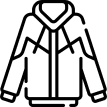Ever wondered what type of printing is appropriate for your custom apparel? It can be confusing whether to choose screen printing or DTF printing, especially in the event that high-quality prints with a longer lifespan are required. The wrong choice could cause print color issues, high costs, and problems with maintaining your garments.
But don’t worry, because this article will break down both methods in easy to understand terms, so you can confidently decide which one suits your project best.
Whether you need bulk orders with vibrant prints or complex prints on multiple fabrics, we’ve got you covered. After reading this article, you’ll have a better whether screen printing or DTF printing is the better pick for your custom apparel.
Let’s get started.
What is Screen Printing?
Screen printing is a traditional and widely used method of printing a design on fabric. It involves preparing a stencil (or screen) for each color in the design and pressing ink through the screen on the fabric. It produces high-quality prints with excellent longevity and bright colors.
Advantages of Screen Printing:
- Durability: The permanent ink in screen printing is ideally suited for prints that are going to sustain multiple washings.
- Vibrant Colors: Screen printing results in bold and vivid colors due to it operating on the RGB color scale, as opposed the the CMYK scale.
- Cost-Effective for Bulk Orders: Once the setup is in position, high-volume printing is quite low cost on a per unit basis.
- Versatile: Works on a variety of fabrics, e.g., cotton, polyester, and blends.
Disadvantages of Screen Printing:
- High Setup Cost: One screen is required for each individual color therefore making it a little labor intensive .
- Not Ideal for Small Orders: Due to the setup process, a small order is not economically viable.
- Higher Cost When Printing Gradients: Gradients and fine detail are difficult to print and therefore you will most likely need to find an experienced specialist printer which can sometimes make costs higher.
What is DTF Printing?
DTF (Direct-to-Film) printing is a newer method in which the design is printed on fabric with a special film and a heat press. Unlike screen printing, DTF doesn’t require a screen for every color.
Advantages of DTF Printing:
- No Color Setup Cost: Unlike screen printing, there is no need for a screen per color, and thus, it is a lower-cost method in multicolor prints when printing smaller quantities.
- Works on Multiple Fabrics: Can be applied on cotton, polyester, nylon, fleece, and more.
- Great for Small Orders: With no complex setup process, DTF is cost-effective even for one off or small batch orders.
Disadvantages of DTF Printing:
- Less Durable: While DTF prints are placed, they are not quite as wash resistant as screen printed graphics.
- Different Texture: The prints on DTF are a little raised in touch in comparison with the screen printed finish.
Screen Printing Vs. DTF Printing: What’s the Difference?
Screen printing and DTF printing are both popular methods for creating personalized clothing, but they have notable distinctions in process, durability, and cost.
The following is a comparison of the two approaches:
Printing Process
Screen printing is the traditional method of producing stencils (screens) for every shade in a design. Ink is pushed through the screens onto the fabric in order to get a bold and hard-wearing print. Since a distinct screen is required for every shade, complex designs with multiple colors are not only labor-intensive but also quite costly.
DTF printing, on the contrary, prints a design on a special film using a digital printer. The printed film is then transferred onto the fabric using a heat press afterward. There is no requirement for separate screens for each color in DTF as in screen printing, and hence, it is more appropriate for designs that have multiple colors and are more complex when needing smaller quantities.
Color Limitations and Design Complexity
Screen printing is particularly well-suited for basic bold graphics with block colors. Since every shade in a design is printed on a separate screen, having lots and lots of colors in a design would skyrocket costs and production times.
DTF printing facilitates setup-free full-color prints. It is compatible with fine detail prints, gradient prints, and photograph-grade prints and is applicable in complicated graphics. It is useful in high-demand graphics companies with apparel.
Durability and Longevity
One of the greatest strengths of screen printing is how durable the prints are. The ink is pressed deep within the fabric, resulting in prints that resist fading and cracking even with repeated washes. Because of this, screen printing is a top pick among uniforms, sports jerseys, and special event products where quality is needed over a longer lifespan.
DTF prints, while durable, don’t penetrate the fabric nearly as deep as screen-printed ink. Eventually and with multiple washings, DTF prints may show signs of wear and tear in advance of screen-printed graphics. But they still possess a high degree of resilience, provided they are properly cared for.
Setup Costs and Order Size
Screen printing has a complex setup process because each color in a design is printed on a separate screen. It is a more costly process upfront but is a better value in large volume orders over low volume orders. Once the screens are produced, however, getting a high quantity print, is relatively inexpensive on a per-unit basis.
DTF printing is low in setup costs because there are no screens and no standalone color layers. It is a viable option for low-] volume orders, bespoke prints without the added expense, and one-offs.
Fabric Compatibility
Screen printing is applicable to a variety of fabrics such as cotton, polyester, and blends. It is not applicable to other manmade fibers such as nylon and fleece without treatment, which is possible but does add to the cost.
DTF printing is highly adaptable and can be used on a wide range of fabrics such as nylon, polyester, fleece, and even leather. It is a better choice for businesses that need to print on multiple fabric types without needing to change printing processes.
Feel and Touch of the Print
Screen-printed designs are even and soft in finish because fabric and ink are a balanced combination. The prints are comfortable and fit naturally with the fabric.
DTF prints, on the other hand, are a bit uneven in texture since they are on top of the fabric and not infused into the garment. While not a quality issue, a smoother finish is what a handful prefer in screen-printed apparel.
Select Screen Printing When:
- You need a high quantity of printed apparel (e.g., uniforms, special event t-shirts).
- Your design is uncomplicated in color and doesn’t require fine detail.
- You want prints with a high degree of wash resistance.
- Your budget supports greater initial setup costs in order to receive lower costs on a per unit basis in quantity.
Choose DTF Printing When:
- You receive few or custom orders, e.g., a one print order.
- Your design has numerous colors, gradients, or fine elements.
- You need to imprint on a variety of fabrics, even on synthetic fibers.
- You prefer a lower setup charge and a quicker turnaround.
Final Words
Both DTF printing and screen printing have their own uses, and which one you prefer might depends on what you particular projects requirements are. If you want prints with high durability on large orders with a bright colors, screen printing is the preferable option. But if you need multicolor prints on different fabrics with low quantities and low setup costs then DTF printing is a better option.
By understanding these differences, you’ll be able to choose the optimum printing method for your bespoke apparel projects with confidence.
FAQs
Which printing method is cheaper in smaller amounts?
DTF printing is the better choice in low order prints because there are no high setup costs in screen printing. Since screen printing uses a screen for each color, setup is a high cost and labor-intensive process. Furthermore, DTF printing is compatible with full color, complex prints without extra fees and therefore is a better choice for a low volume or a single order.
Which method is longer-lasting on fabric?
Screen printing is incredibly resistant and long-lasting. The screen printed ink is firmly ingrained in the fabric and is resistant to wash, stretching, and everyday wear. It is a great choice for uniforms, sports shirts, and other products intended for frequent use. While DTF prints are very resistant, they are going to start fading and cracking a little sooner than screen printed graphics, especially without proper care.
Can DTF printing be used on dark fabrics?
Yes, DTF printing is ideally suitable for dark and light fabrics. Unlike other digital printing technologies where a white under base is required on dark fabric, DTF printing involves a white layer under the design in the process. It makes the colors vibrant and legible regardless of what fabric is printed. It is a wonderful solution with which to print on a wide variety of apparel. But keep in mind that screen printing works just as well on darker fabrics.
Does screen printing accommodate every fabric type?
Screen printing is particularly well-suited to cotton, polyester, and blends. It is possible on other man made fibers such as nylon and fleece but is inclined to require special treatments or additives in order to adhere correctly. Certain fabrics, such as highly stretchy fibers and heat-reactive fibers, are not suitable. If a high degree of variety in fabric type is desired, DTF printing would be a better choice.









